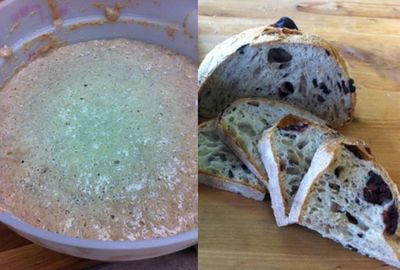
Over on the Orange Boot Facebook page, Gwen asks: "As someone who 'captures' this thing, could you expand for our FB friends what [sourdough or wild yeast] is exactly?"
Sure thing, Gwen!
First off, let's talk about "commercial" yeast. You can buy it Fresh, Active Dry, or Instant, manufactured by Fleishmans or Lesaffre, but it's really all the same thing: a single strain of yeast cells (Saccharomyces cerevisiae) that is cultivated by the yeast manufacturer. Then large quantities of yeast cells are compressed and/or dried, packaged and sold to bakers. Years ago, this yeast was a byproduct of beer brewing, but now it's manufactured on its own.
There's nothing wrong with commercial yeast. It does its job very well -- making your dough rise (aka leavening.) But that's really all it does.
A sourdough culture (also called a levain) is a different beast all together. The baker creates and perpetuates a sourdough culture to accomplish two goals: raise the dough and develop flavour. That's accomplished by keeping two organisms healthy and flourishing in the culture:
- "wild" yeast: This is a slightly different yeast cell, called Sacchraromyces exiges. This organism exists in the air, on our hands, and especially in flour. All we have to do is capture it and help it multiply, and it will raise our bread.
The main difference between it and Saccharomyces cerevisiae is the "wild" yeast likes a more acidic environment. Good thing too, because a sourdough culture is more acidic than a "normal" bread dough!
- lactic acid bacteria: This single celled organism is the bread baker's best friend. The little guys converts sugars in the flour into lactic acid, giving the loaf a delicate, yogurty tang. The extra acidity also helps the loaf stay fresh longer. Different regions of the world have different lactic acid bacteria, which helps sourdough bread taste different in other parts of the world. For example, the cool, humid climate of San Francisco has created a specific strain called Lactobacillus sanfranciscensis.
And that's what a sourdough culture is all about. Hah! Not by a long shot. There's much more to the sourdough story. Next time, I'll focus on what we can do as bakers to create different flavour profiles with your sourdough culture.
Do you like knowing what goes into your daily bread? What did I miss explaining? What other topics are you interested in learning about? Let me know in the comments!
This is the first in a three part series of articles about sourdough culture. The second describes all the critters that bring flavour to your sourdough bread. The third article discusses how bakers can control these critters in our baking, or at least suggest specific flavour profiles.